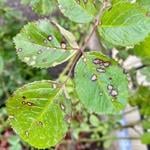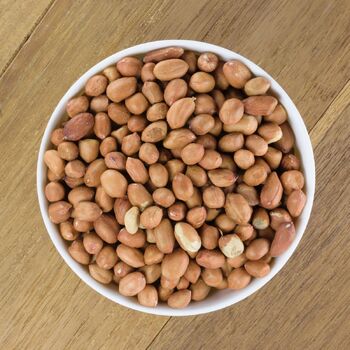
How to Grow Peanut Seeds
Grow Guide #2927
Family: Fabaceae
Binomial name: Arachis hypogaea
Life Cycle: Annual
This 'How to Grow' guide details everything a home gardener needs to know to plant, grow and care for Peanuts (Arachis hypogaea).
When to Sow Peanut Seeds
Peanut is a warm season crop. Use the table below to identify the best time of year to sow peanut seeds in your climate.
| JAN | FEB | MAR | APR | MAY | JUN | JUL | AUG | SEP | OCT | NOV | DEC | |
|---|---|---|---|---|---|---|---|---|---|---|---|---|
| Cool | ||||||||||||
| Temperate | ||||||||||||
| Sub-Tropical | ||||||||||||
| Tropical | ||||||||||||
| Arid |
Preparation
Peanut plants are best grown in full sun. Choose a location that will receive at least 6 hours of full sun each day.
Peanut plants need a loose, well drained soil enriched with organic matter. Prepare soil by weeding it thoroughly, digging it over to at least a spade’s depth to loosen the soil, and adding aged animal manure or compost. Organic matter can be dug into heavy soil to lighten it so roots can grow freely. Keep the area free of weeds until planting. Learn more about preparing soil for planting here.
Peanut plants can be grown in containers. If possible choose a variety that’s recommended for container growing. Use a good quality potting mix and make sure your container is large enough for mature plants; a minimum of 20 litres is recommended for peanuts. During the growing season, keep in mind that container grown plants may need additional fertiliser to encourage healthy growth.
How to Sow Peanut Seeds
Optional: Soak the seeds overnight in room temperature water before planting.
Peanut seeds can be sown directly into the garden OR seedlings can be raised in trays or other containers and transplanted to the garden once established.
Sow Direct
- Sow seeds directly in the garden 30mm deep and 15-30cm apart, with rows 60cm apart.
- Keep soil moist but never wet or dry.
- Seeds should germinate in around 7-15 days at a soil temperature of 18-22°C.
- Young seedlings will need protection from pests, pets and weather until they are established.
Raise Seedlings
- Fill trays, punnets or jiffy pots with a good quality seed-raising mix, or use soil starter pellets.
- Sow seeds 30mm deep.
- Keep soil moist but never wet or dry.
- Seeds should germinate in around 7-15 days at a soil temperature of 18-22°C.
- Transplant seedlings to the garden once they have their first true leaves and are large enough to handle (usually 5-10cm tall).
- Plant out, spacing plants 15-30cm apart, with rows 60cm apart.
Peanut is a tender crop that’s sensitive to frost. Do not transplant seedlings or sow seeds outside until all danger of frost has passed.
Optional: In cool climates peanut seeds can be sown indoors 6 weeks before the last expected frost. Grow them in a warm position with plenty of natural light.
How to Grow Peanut
Peanut plants may need watering during the growing season. Water when the soil is dry about 5cm below the surface (test this by scratching away a little soil with your finger). Water deeply in the early morning or late afternoon. Avoid watering the leaves of plants to avoid fungal diseases. Learn more about watering here.
As peanut is a legume no added fertiliser should be necessary if plants are grown in well-prepared soil, but some gardeners apply half a handful of gypsum per plant when plants are flowering to provide extra calcium for shell formation.
Plants flower approximately 40 days after seeds germinate.
After pollination, the fertilised flowers form what are known as 'pegs'. These drop to the ground due to gravity, and the peanut shells (actually pods) then develop underground. The shells develop first, followed by the peanuts. Do not remove flowers or prune off the flower stems or pegs as this will prevent peanuts from being produced.
How to Harvest Peanuts
Peanuts should be ready to harvest in approximately 90-130 days.
Plants are ready to harvest when the foliage yellows and dies off in autumn. Harvest a single plant to check for ripeness: the shell should have prominent veining and skins of the peanuts should be coloured, not white. Peanuts mature gradually rather than all at once, so aim to harvest when around two-thirds of the crop is mature.
Using a garden fork, gently lift entire plants from the ground and shake off excess soil. Leave plants to cure for around a week by laying them on the soil or, if rodents are likely to eat the crop, by hanging them in bunches in a warm, dry place. Separate the shells from the dried plants, discarding any immature or 'green' pods which will be soft with peanuts that are not fully coloured. Dry the shells in a cool, dry place on a wire rack for a further one to two weeks. Peanuts can be stored in their shells, or the shells removed. Store in a mesh bag, or freeze for longer term storage.
Common Problems when Growing Peanuts
Like all plants, peanut is susceptible to some pests, diseases and other problems. Below is a list of the most common problems gardeners encounter when growing peanut plants:
 Bacterial leaf spot is a disease that causes irregularly shaped brown spots on all above-ground parts of a plant. The spots at first appear to be wet but become dry and scab-like over time. Leaves and flowers can fall prematurely. Water plants at soil level (not on the leaves), dispose of fallen leaves and fruit and practice crop rotation.
Bacterial leaf spot is a disease that causes irregularly shaped brown spots on all above-ground parts of a plant. The spots at first appear to be wet but become dry and scab-like over time. Leaves and flowers can fall prematurely. Water plants at soil level (not on the leaves), dispose of fallen leaves and fruit and practice crop rotation.


.png)



